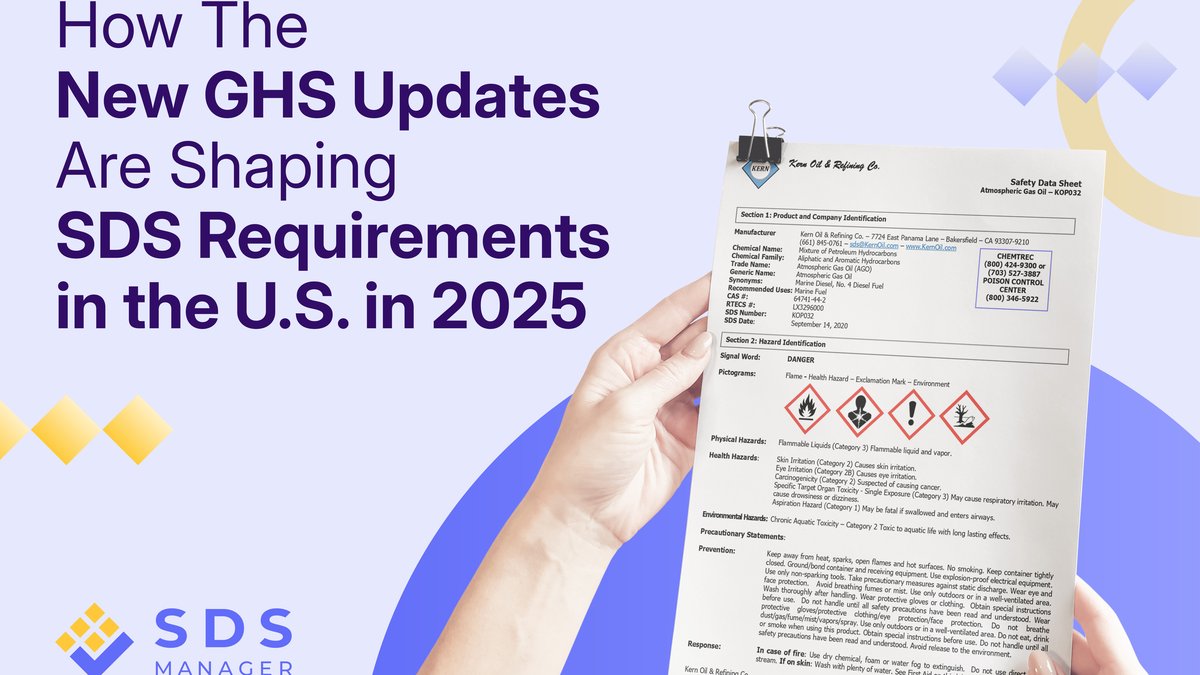

The Globally Harmonized System (GHS) continues to evolve, and in 2025, the United States is seeing important updates that are reshaping Safety Data Sheet (SDS) requirements under OSHA’s Hazard Communication Standard (HCS). These changes aim to improve hazard communication, ensure timely updates of safety information, and enhance compliance across workplaces handling chemicals. Understanding these updates is critical to maintaining effective SDS management and protecting worker safety.
Key GHS Updates in 2025
1. Updated OSHA Hazard Communication Standard (HCS)
OSHA’s revised HCS, effective July 19, 2024, aligns more closely with the UN’s GHS Rev. 7 and introduces stricter requirements for SDS content, format, and labeling. The updated standard improves hazard classification criteria and mandates a uniform 16-section SDS format to ensure consistency and clarity.
2. Stricter SDS Update and Submission Timelines
Chemical manufacturers, importers, and employers must revise SDSs within 90 days of becoming aware of significant new hazard information. Facilities that have submitted SDSs to Local Emergency Planning Committees (LEPC), State Emergency Response Commissions (SERC), or local fire departments must also resubmit revised SDSs when hazard classifications change [see here]. This ensures all stakeholders have access to the most current safety data.
3. Enhanced Labeling Requirements
Labels on chemical containers must reflect updated hazard classifications and may include QR codes linking directly to SDSs, facilitating immediate access to safety information on the worksite. Secondary container labeling requirements have also been reinforced to ensure all chemicals are properly identified [see here].
4. Increased Employer Responsibilities for Training and Communication
Employers must provide updated training to employees on interpreting revised SDSs and labels. This includes ensuring workers understand new hazard classifications and protective measures. Maintaining an accurate chemical inventory and SDS library is also a key compliance requirement.
5. Improved Recordkeeping and Electronic Reporting
OSHA encourages enhanced digital recordkeeping for workplace injuries and illnesses, including electronic reporting through OSHA’s Injury Tracking Application. Accurate and accessible SDS records are essential for inspections and audits.
How These Updates Are Shaping SDS Management in U.S. Workplaces
The 2025 updates to the Globally Harmonized System (GHS), integrated into OSHA’s revised Hazard Communication Standard (HazCom), are raising the bar for how businesses manage Safety Data Sheets (SDS) in the U.S. These changes place a strong emphasis on accuracy, transparency, and timely communication of chemical hazards in the workplace.
To remain compliant, organizations must focus on the following:
- Proactive SDS reviews and updates
- Accurate chemical inventory systems linked with current SDSs
- Digital access tools like QR codes to streamline safety information
- Targeted employee training that covers new SDS and labeling standards
- Strong recordkeeping practices to demonstrate compliance during inspections
Here are the key milestones to keep on your radar
- July 19, 2024: Effective date of OSHA’s revised Hazard Communication Standard, including updated SDS and labeling requirements.
- Ongoing 2025: Facilities must comply with SDS revision and resubmission requirements within 90 days of new hazard information discovery.
- Continuous: Employers must maintain accurate chemical inventories, provide employee training, and keep records accessible for OSHA inspections.
Staying ahead of these changes is not just about meeting legal obligations, it’s a proactive step toward protecting worker health and promoting a safer, more informed workplace.
How SDS Manager Can Help
Navigating these complex and dynamic SDS requirements demands robust SDS management solutions. SDS Manager offers a comprehensive platform designed to keep your chemical safety program aligned with the latest GHS standards.
Key Features That Help You Stay Compliant:
- Extensive safety data sheet Database & Import Tools: Access more than 16 million SDSs and easily import your chemical inventory to build a complete, up-to-date safety data sheet library.
- Automated safety data sheet Updates: Receive timely notifications for safety data sheet revisions and updates, ensuring your data reflects the latest hazard information.
- One-Click Access to Safety Information: Instantly access hazard details, PPE icons, first aid instructions, and spill precautions. Generate Safety Information Summaries for employee guidance.
- Secondary Container Label Generation: Create compliant labels in multiple sizes featuring QR codes, hazard codes, and PPE icons to meet labeling requirements.
- QR Code Integration & Mobile Access: Generate QR codes and posters for instant safety data sheet access on mobile devices, improving hazard communication and worker safety.
- Compliance Reporting: Generate detailed reports to stay audit-ready and demonstrate regulatory compliance effortlessly.
Getting Started Is Easy
Here's how you can take the next step toward streamlined chemical safety and compliance:
- Contact Us For Free Setup Support
- Uncover Features Designed With Your Challenges In Mind
- Book A 1:1 Consultation To Discuss Unique Compliance Needs
Take the First Step Toward Smarter SDS Management: Start Your Free Trial Today!